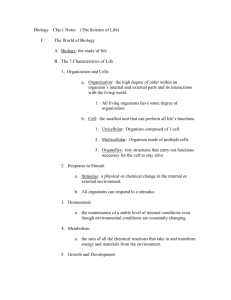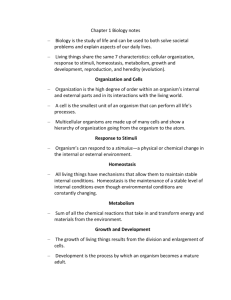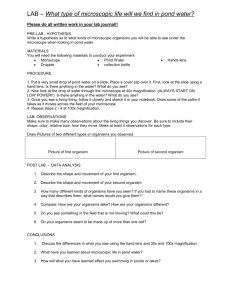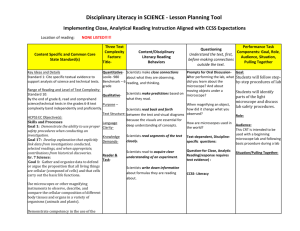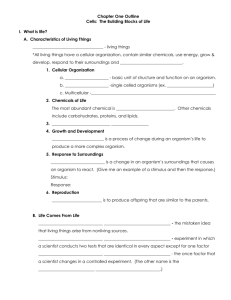Science of Life Review - Answers Updated 2014
advertisement
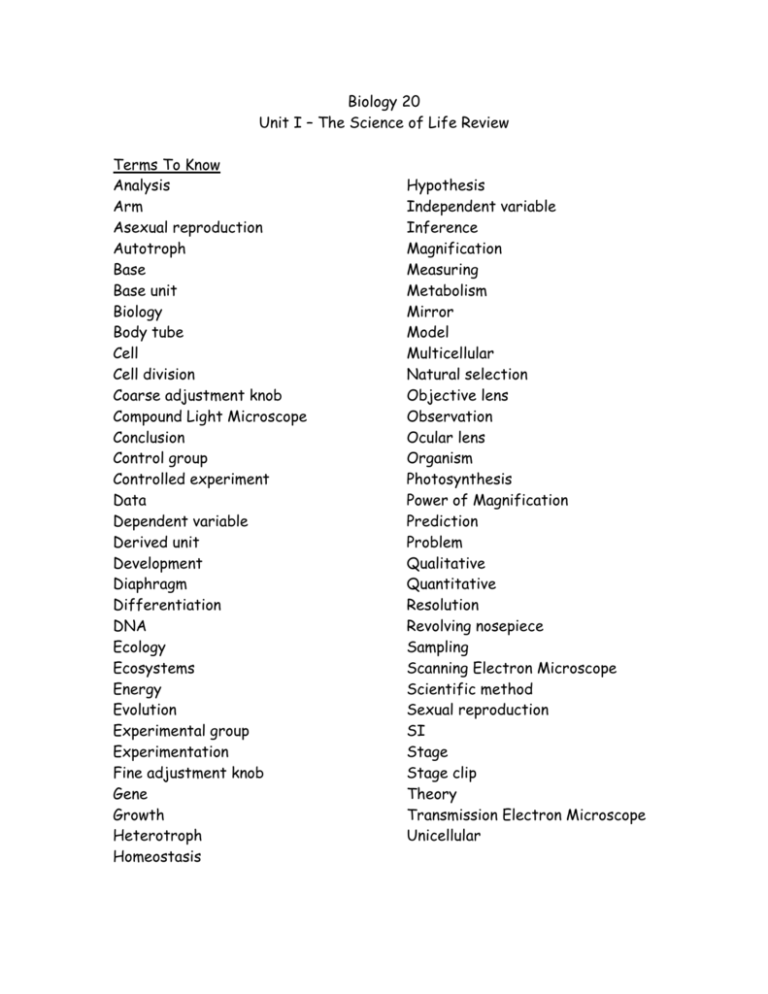
Biology 20 Unit I – The Science of Life Review Terms To Know Analysis Arm Asexual reproduction Autotroph Base Base unit Biology Body tube Cell Cell division Coarse adjustment knob Compound Light Microscope Conclusion Control group Controlled experiment Data Dependent variable Derived unit Development Diaphragm Differentiation DNA Ecology Ecosystems Energy Evolution Experimental group Experimentation Fine adjustment knob Gene Growth Heterotroph Homeostasis Hypothesis Independent variable Inference Magnification Measuring Metabolism Mirror Model Multicellular Natural selection Objective lens Observation Ocular lens Organism Photosynthesis Power of Magnification Prediction Problem Qualitative Quantitative Resolution Revolving nosepiece Sampling Scanning Electron Microscope Scientific method Sexual reproduction SI Stage Stage clip Theory Transmission Electron Microscope Unicellular Questions For Review (70 marks) 1. List six unifying themes of biology. The six themes discussed in the chapter include cell structure and function; /6 stability and homeostasis; reproduction and inheritance; evolution; interdependence of organisms; and matter, energy, and organization. /2 2. How do organisms produce offspring like themselves? Organisms transmit hereditary information to their offspring in the form of DNA. /2 3. What are two of the driving forces behind the process of natural selection? (a) Organisms in a population must compete for limited resources. (b) Individuals in a population differ from one another. Some have traits that allow them to reproduce more successfully than other organisms. /2 4. Why do biologists say that living things are organized? They have a high level of molecular and cellular organization, showing more complex structure than nonliving things. /3 5. Why are rainforests considered fragile environments that are vulnerable to permanent destruction? Rain forests typically support large numbers of plants and animals on a thin layer of topsoil. Removal of vegetation leads to depletion of soil nutrients and hardening of the soil, eliminating the possibility of reforestation. /2 6. What is the difference between asexual reproduction and sexual reproduction? Sexual reproduction involves the combining of genetic material form different individuals, while asexual reproduction does not. /2 7. How do autotrophs differ from heterotrophs in obtaining energy? Autotrophs synthesize the nutrients they need from simple substances, in most cases using the energy they trap from the sun. Heterotrophs must rely on other organisms in order to obtain the nutrients they need as their energy source. /2 8. Why do scientists say that the environment “selects” the traits that allow an organism to survive and reproduce? The traits that are helpful to an organism depend almost entirely on that organism’s interaction with the environment. /6 9. Name six characteristics that all living things share. Cellular composition, organization, use of energy, homeostasis, growth, and reproduction /2 10. What are two levels of organization found in living things? Molecular and cellular organization /3 11. How does growth of a nonliving thing differ from growth of a living thing? Some nonliving things, like rock crystals, grow by accumulating more of the materials they are made of. Living things grow by cell enlargement and cell division. /2 /2 /4 12. Why is reproduction an important characteristic of life? Reproduction is not vital to the survival of an individual, but it is vital to the continuation of life. 13. Why are so many organisms yet to be discovered identified, and described? There is a great diversity of life, and many organisms are relatively inaccessible to scientists. 14. How are the processes of inferring and modeling useful to scientists? Inferring enables scientists to draw conclusions without making direct observations. Modeling enables scientists to understand the relationships among data they have collected or observations they have made. /4 15. What is the relationship between hypothesizing and experimenting in science? Hypothesizing is forming a testable statement about observable phenomena. Experimenting is testing a hypothesis or prediction by gathering data under controlled conditions. /2 16. What is the relationship between a hypothesis and a prediction? A hypothesis is a testable explanation of observable phenomena and data. A prediction is a statement of expected results of testing the hypothesis. /1 17. What role does communication play in science? Communication enables scientists to build on each other’s work and findings. /1 18. Explain why there is no single scientific method. Scientists use a variety of methods, depending on the nature of their work. /2 19. How does a theory differ from a hypothesis? A hypothesis is a testable statement, based on observation. A theory is a broad statement of what is thought to be true, based on the testing of many hypotheses. /6 20. How do microscopes differ in magnification and resolution? Some light microscopes magnify up to 2,000 X, but as the power of magnification increases, the resolution drops. A TEM microscope magnifies up to 200,000 X and can distinguish the internal structure of specimens. An SEM magnifies up to 100,000 X and provides three-dimensional images of the surface of a specimen. /2 21. How is the maximum power of magnification computed for a compound light microscope? The power of magnification of a microscope is the product of the power of magnification of the ocular lens and that of the most powerful objective lens. /4 /2 /3 /3 22. Describe the similarities and differences between a transmission electron microscope and a scanning electron microscope. A TEM transmits electrons through a thinly sliced specimen and magnifies the image of the specimen up to 200,000X. An SEM scans the surface of a specimen with a beam of electrons and magnifies the image of the surface up to 100,000X. 23. If SI measurement is no more accurate than the English system, why do scientists throughout the world use it? Conversions among SI units are simple, allowing scientists to manipulate data much more easily than if they were working with English units. 24. One of the first branches of biology to be developed was taxonomy, the naming of organisms. Why is taxonomy important to communication about biology? Organisms had to be named or described before different scientists studying them independently could accurately compare their results. 25. Scientists know that a disease-causing organism can cause overwhelming illness or death very quickly. Why would it not be adaptive for a diseasecausing organism to kill its victims too quickly? If it kills its host before it can multiply and be passed to another host, it will die off.
